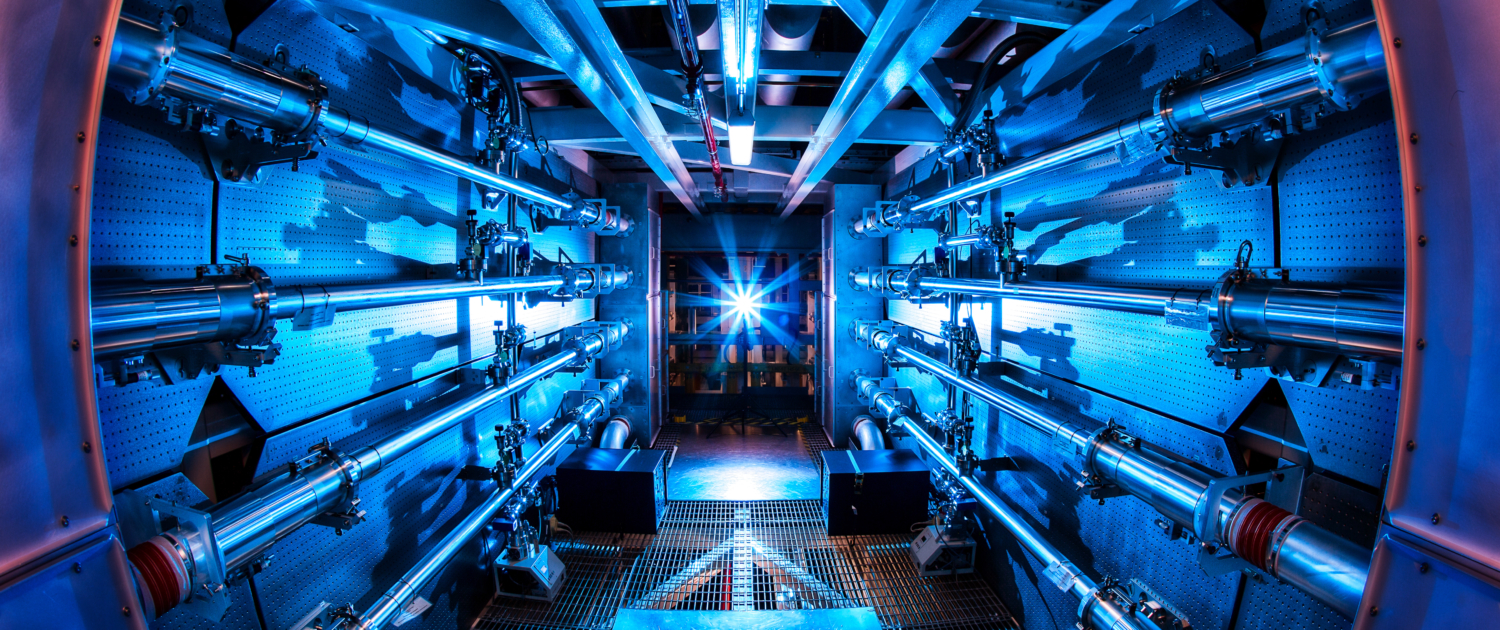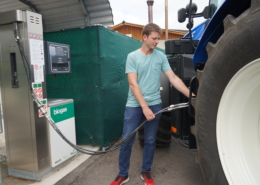Nuclear fusion - the dream of an endless stream of clean energy
On December 5, 2022, researchers in the U.S. achieved a historic breakthrough in nuclear fusion, according to media reports. For the first time, an experiment at Lawrence Livermore National Laboratory in California succeeded in releasing more energy than was put into it. The world's most powerful laser system heated a tiny amount of deuterium and tritium to more than 100 million degrees Celsius, creating a plasma in which the two hydrogen isotopes fused to form helium. The plasma received 2.05 megajoules of energy from the lasers, while the fusion produced 3.15 megajoules. However, the energy gain refers only to the nuclear experiment. The total electricity demand of the experimental reactor is still much greater than the energy generated. The 192 lasers required 322 megajoules of energy alone to generate any laser light at all. The experiment is a success for science because it finally proved that nuclear fusion can produce energy. However, it will be many years or even decades before commercial fusion reactors will feed energy into the power grid.
Myths and dreams surround nuclear fusion
Since ancient times, mankind has dreamed of bringing the fire of the sun to earth, like Prometheus. The ancient human dream of a safe, clean and inexhaustible source of energy lives on today in nuclear fusion. Today, nuclear fusion still raises the hope of being able to solve the global energy problem forever in a few decades. Unlimited cheap raw materials are to be used to produce unlimited energy. The scarcity of raw materials as a cause of wars is to be eliminated and mankind is to be freed from poverty, conflicts and environmental pollution. Nuclear fusion shall even help to save mankind from extinction.
In contrast to nuclear fission, nuclear fusion cannot cause a nuclear chain reaction and thus a meltdown. There is hardly any radioactive waste to be disposed of safely for a long time, and no climate-damagingCO2 is released. Nuclear fusion promises to replace all fossil fuels and eliminate the problem of pollution and global warming. Deuterium occurs in water and is therefore almost unlimited on our planet in the world's oceans. Lithium, from which tritium is produced, is somewhat less abundant in nature, but the world's deposits of it would also be sufficient to meet the entire global energy demand for several tens of thousands of years.
If we look at the myths and dreams surrounding nuclear fusion, it becomes obvious what research has not yet achieved despite significant progress. As historian Simon Märkl has shown in his book Big Science Fiction, utopian visions of the future also found expression in American popular culture during the Cold War. The energy company General Electric, for example, staged nuclear fusion as the energy of the future in Walt Disney's futuristic "Progressland" building at the 1964/65 New York World's Fair. And in the 1985 science fiction film comedy "Back to the Future," Doc Brown's time machine is powered by the "Mr. Fusion Home Energy Reactor," which uses household waste as fuel.
The first really big man-made nuclear fusion succeeded on November 1, 1952, with the detonation of the first American hydrogen bomb, "Mike." The explosion was so immense that the Pacific island of Elugelab instantly vaporized. After the power of the sun had been unleashed in its destructive form on Earth, the intention was to tame it and make it usable for peaceful purposes as well. The idea of nuclear fusion as a source of energy first came to Soviet physicist Oleg Lavrentyev in 1949. His proposal of a fusion reactor led Andrei Sakharov and Igor Tamm to develop the concept of the tokamak in 1952. The toroidal fusion reactor, based on the method of magnetic plasma confinement, is the type of reactor that is still most widely promoted today.
ITER - the largest fusion reactor in the world
in 2005, the EU, India, Japan, South Korea, Russia, China and the U.S. decided to build the ITER research reactor in Cadarache in southern France. The 22-billion project is one of the largest experiments in human history. The research reactor, which is also based on the tokamak principle, has been under construction since 2013. In a second stage, the first prototype of a commercial fusion reactor "DEMO" will then be built. The goal is to have a working fusion power plant in the second half of the century. The project was an idea of Mikhail Gorbachev, which he proposed at the 1985 Geneva summit with Ronald Reagan to improve relations between East and West. Today, ITER is the world's largest energy research project.
All the countries involved are working together, but they also want to benefit their own industries. Certain components of the research reactor are being developed by several countries simultaneously. International cooperation therefore often resembles a diplomatic egg dance. Costs have multiplied since the project began, and delays have occurred time and again. Even during the construction of the research reactor, the design has been changed several times. ITER may be the way out of the world's energy crisis or it may become one of science's most expensive failures. ITER must prove that a fusion reactor can work. If ITER doesn't succeed, that's probably it for fusion, proponents say. It's like building a cathedral: it takes several generations for the cathedral to stand.
Critics claim that nuclear fusion will remain a utopia forever. Nuclear fusion is the energy form of the future - and will always remain so. In the fight against climate change, nuclear fusion comes too late anyway, and the money would be better invested today in the expansion of renewable energies. In the next 20 years, nuclear fusion cannot contribute toCO2 reduction. Proponents see nuclear fusion in the future as an ideal complement to the technologies that already exist today. "The few promising options we have should not be played off against each other," says Christian Theiler, professor of plasma physics at EPFL Lausanne, for example. What is needed today is both basic research and the expansion of renewable energies, as well as bridging technologies such as nuclear energy based on nuclear fission.
Some researchers assert that the key to success lies solely in putting more money into fusion research in order to make faster progress. Today, they say, one must invest in many different projects and consider every new idea. Around the world today, numerous start-ups are working on prototype fusion reactors. Every few months, you hear that this or that company has just made a breakthrough. However, many full-bodied promises made by these private start-ups are not realistic. They are mainly good marketing so that their backers don't bail out. However, some private initiatives, such as Commonwealth Fusion Systems, a spin-off from the Massachusetts Institute of Technology (MIT), with its concept of a compact high-field tokamak, are quite promising.
In any case, there are still some tough nuts to crack on the way to a fusion power plant. To enable efficient power generation, the thermonuclear fire must burn longer and be kept under control. The plasma, which has a temperature of over 100 million degrees Celsius, must be efficiently contained and stabilized. Or as plasma researcher Eric Lerner puts it in the documentary film Nuclear Fusion - The Dream of Solar Energy, " The plasma is supposed to sit still like a good dog, so to speak. The only problem is that the plasma doesn't want to sit still." Some of the most powerful supercomputers in the world today calculate the behavior of plasma for research laboratories. Mathematical models are used to map the highly complex physical processes in the plasma. The reliability of the models has to be tested again and again in experiments.
Large superconducting magnetic coils must be constructed for magnetic confinement. Sufficient tritium must be produced in the reactor with the help of neutrons from the fusion reactions, and the tritium injected into the plasma from outside must be burned as efficiently as possible. The walls of the vacuum chamber must be able to withstand extremely high temperatures, and the interactions of the plasma with the walls must be reduced as much as possible so that the reactor is not damaged or destroyed during operation. Nuclear fusion still succeeds only for a very short time. For a reactor to be profitable, the energy confinement time must be increased. The energy confinement time of a plasma increases with its size. That's why we need the really big experiments like ITER. The reactor should one day deliver a fusion power of 500 megawatts for a period of a few minutes, with an injected power of 50 megawatts.
Swiss Plasma Center at EPFL Lausanne
Switzerland has been strongly committed to nuclear fusion since the founding of what is now the Swiss Plasma Center in the 1960s. Today, the Swiss Plasma Center at EPFL Lausanne is one of the world's leading fusion research laboratories. Since 1979, Switzerland has worked with the European Atomic Energy Community (Euratom) and was associated with its research and training program in nuclear fusion from 2004 to 2020. As a member of the European Fusion for Energy, Switzerland participated in the construction of ITER from 2007 to 2020, paying 274.5 million Swiss francs to the EU over the same period. At the same time, ITER has resulted in orders worth 190 million Swiss francs for Swiss companies from 2007 to 2019. Switzerland took on key tasks early on in the ITER project. For example, all superconducting components of the magnets were tested by the Swiss Plasma Center at the Paul Scherrer Institute (PSI) in Villigen.
After the failure of the Framework Agreement, Switzerland became a non-associated third country in Horizon Europe and thus also in the Euroatom research and training program. Its participation in the ITER project and in the operational activities of Fusion for Energy were suspended. The exclusion of Switzerland from the ITER project is difficult for the Swiss Plasma Center. International cooperation is crucial, especially in the field of fusion research. Without formal participation in ITER, Swiss researchers can no longer influence the further development of the project. The full participation of the Swiss Plasma Center in the ITER project is also in the interest of the European research community. In addition, Swiss industrial companies may no longer participate in tenders for the supply of components and services in connection with ITER.
In order to ensure the continued collaboration of the Swiss Plasma Center with European fusion research, an agreement could be concluded between EPFL Lausanne and Fusion for Energy, at least at the operational level. The Swiss Plasma Center can also continue to participate in the Euratom research and training program as an associated partner of the Max Planck Institute for Plasma Physics in Garching near Munich, which coordinates the consortium of European fusion research laboratories (EUROfusion). Funding for Swiss fusion research in connection with the Euratom program and institutional cooperation with Fusion for Energy is now provided by the State Secretariat for Education, Research and Innovation (SERI) as part of its transition measures to Horizon Europe.
The Swiss Plasma Center's TCV Tokamak experimental reactor is one of the most important fusion research facilities in Europe, allowing further research into the physics of nuclear fusion by magnetic confinement. The Swiss Plasma Center helps to demonstrate the scientific and technological feasibility of controlled nuclear fusion on Earth, showing that nuclear fusion can be used commercially in the future. Today, the Swiss Plasma Center has about 120 employees and more than 40 PhD students. In plasma theory and simulation, superconductivity, plasma physics and optimization of the tokamak concept, the Swiss Plasma Center makes important contributions to international fusion research.
Today, energy production from nuclear fusion still seems like a distant dream, but in a few decades, mankind may be grateful to be able to use a technology that reliably produces safe andCO2-free energy. Or as NZZ journalist Andreas Hirstein put it: "Perhaps in 2100, our great-great-grandchildren will one day marvel at their ancestors who were so far-sighted as to invest 100 years in a technology whose realization was considered impossible and yet which was pushed ahead because its advantages are so enormous."
How does nuclear fusion work?
Nuclear fusion is responsible for energy production inside the sun and all shining stars. When light atomic nuclei fuse, a large amount of energy is released. In nuclear fusion, as will be used in future fusion power plants, the nuclei of the heavy hydrogen isotopes deuterium and tritium fuse to form a helium nucleus, releasing a neutron and energy. It takes an enormous amount of energy for the nuclei to fuse together because they are electrically charged and repel each other. The hydrogen isotopes deuterium and tritium must be heated to such an extent, increasing their kinetic energy, that they can break through the electrostatic barrier of the atomic nucleus and fuse to form helium. Deuterium is found in hydrogen, which occurs in nature. Tritium, on the other hand, hardly occurs in nature and must be produced artificially in a reactor. In this process, the lithium isotope Li-6 is irradiated with neutrons. In a fusion reactor, the thermonuclear reaction is used in a controlled manner to generate electricity. Unlike in a hydrogen bomb, where fusion occurs in an uncontrolled manner, only very small amounts of fuel are present in the reactor at any given time. Fusion research today focuses mainly on the tokamak and the stellarator. Both types of reactors are based on the magnetic confinement technique. In this process, the plasma is confined in a magnetic field. The plasma is heated by electromagnetic waves in the spectrum of radio waves and microwaves, and by neutral particle injection, in which a beam of uncharged particles with high energy is shot into the plasma. In inertial fusion, on the other hand, the fusion of deuterium and tritium into helium is achieved by bombardment with laser beams. The energy released by nuclear fusion in the form of heat can be converted into electricity in the fusion reactor by turbines and generators.
 Wikimedia Commons, CC BY-SA 3.0.
Wikimedia Commons, CC BY-SA 3.0.
 ShutterstockDie erste SWEET-Ausschreibung wurde lanciert
ShutterstockDie erste SWEET-Ausschreibung wurde lanciert  shutterstockAbnahmevergütung und Minimaltarife für Photovoltaik-Anlagen: Was hat der Bundesrat für 2026 beschlossen?
shutterstockAbnahmevergütung und Minimaltarife für Photovoltaik-Anlagen: Was hat der Bundesrat für 2026 beschlossen?  Copyright: Ökostrom SchweizKlimafreundlich unterwegs mit Biogas vom Bauernhof
Copyright: Ökostrom SchweizKlimafreundlich unterwegs mit Biogas vom Bauernhof  VenTSolFenêtres ouvertes, stores fermés
VenTSolFenêtres ouvertes, stores fermés 
 BFE
BFE shutterstock
shutterstock
Neuste Kommentare